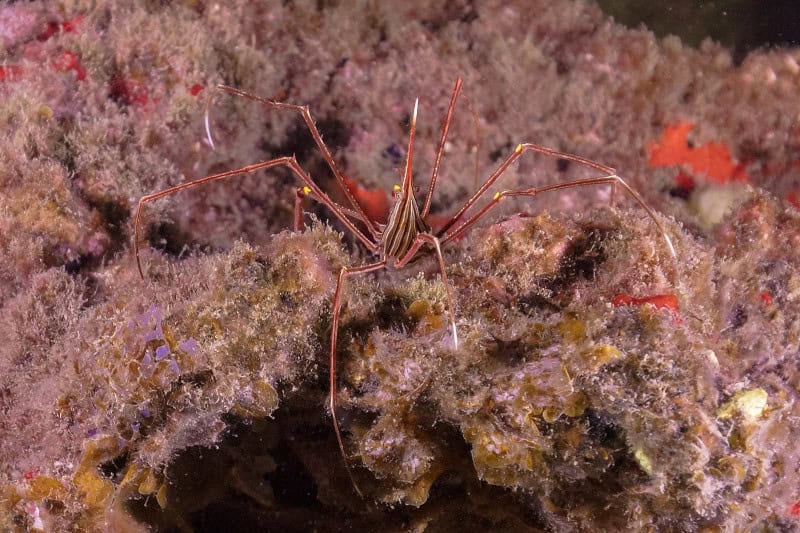
Arrow Crab Facts
- The descriptive term of Arrow Crab serves as the most frequently used common name for this intriguing product of evolution. The animal does have another general name, though. That’s the only slightly more descriptive name of yellowline arrow crab.
- Within scientific circles, however, it’s more typically referred to by its formal moniker. That’s an almost impossible to pronounce term for the layperson, though. That’s because the invertebrate bears the formal title of the Stenorhynchus seticornus.
- It received that tongue-twisting name due to the efforts of the German naturalist, Johann Friedrich Wilhelm Herbst. He accomplished the first official recognition of it as a separate and distinct species. He managed this scientifically noteworthy feat in 1788.
- The population of the Arrow Crab appears to be both sizeable and relatively stable. That fortunate situation also seems to hold true throughout the entirety of its native range. The IUCN, therefore, presently has no listing for it on the organization’s Red List.
- Nevertheless, it must be considered to be facing at least some potential threats to its continued existence. Degradation and outright loss of its native habitat certainly pose dangers to it. Both of these stem either directly or indirectly from climate change.
Related Articles
Arrow Crab Physical Description
The amazing Arrow Crab evolved a physical form that immediately draws the attention of those who encounter it. It does so due to a distinctive trait. That’s the fact that this aspect of the Arthropod presents as vastly different from the majority of related species.
It also differs from most of its kin in that it manifests no discernible degree of sexual dimorphism. This holds true in regards to both overall appearance and sheer size. That tends to make identifying male and female individuals difficult for all but trained experts.
While it impresses observers, it doesn’t do so because of its size. That’s true since it remains a small member of its Order. The central carapace develops as extremely elongated in shape. But, this only attains an average length of roughly 2.4 in (6 cm) in mature adults.
Attached to the slightly triangular body, the rostrum also develops as highly elongated. This protrusion from the head is drawn out into a long point. It additionally displays serrated edges. The combination provides for a highly distinctive physical appearance.
Its legs also manifest as extremely long and relatively thin. These reach an average length of approximately 3.9 in (10 cm). These appendages typically present as either yellow or reddish in color. Strikingly, the attached claws appear as either violet or blue in coloring.
The color patterns of the rest of the body of the Arrow Crab qualify as highly variable between individuals. This also holds true regardless of gender. The body usually shows combinations of yellow, cream, or gold. It’s also marked with brown, black, or blue lines.
- Kingdom: Animalia
- Phylum: Arthropoda
- Class: Malacostraca
- Order: Decapoda
- Family: Inachidae
- Genus: Stenorhynchus
- Species: S. seticornis
Arrow Crab Distribution, Habitat, and Ecology
Unfortunately for it, the fascinating Arrow Crab evolved as native to a somewhat limited region of the globe. Overall, that zone of habitation falls within the boundaries of the Atlantic Ocean. Yet, inside of the that greater area, it appears in only a specific section.
To the north, that territory extends as far as the waters off the shore of North Carolina, in the United States. From that portion of North America, its range runs south to Argentina. Its area of occupation also includes most of the Caribbean Sea, as well as around Bermuda.
It further displays decided preferences in terms of its choice of habitat types. These do, however, serve to limit its area of habitation further. That’s due to the fact that the animal appears almost exclusively in relatively shallow depths. This rarely exceeds 30 ft (9.1 m).
These regions also primarily consist of sections of coral reef. Yet the invertebrate also makes its home in a few other types of habitat, though these usually occur near coral. They include such places as rocky bottoms, gravel and sand regions, and shallow sub-tidal zones.
Much like many of its kindred, the Arrow Crab evolved as primarily nocturnal in activity. It’s also highly territorial in nature. It feeds opportunistically, consuming a range of small invertebrates common to coral reefs. This mainly includes feather duster worms, though.
Breeding occurs at different times across its range, due to local environmental factors. Follwoing mating, however, the female carries the eggs until they’re ready to hatch. Once born, the larvae swim to the surface, and feed on plankton until reaching adulthood.
Species Sharing Its Region
Check out our other articles on 7 Captivating Mammals of Canada, Monarch Butterfly, Deception Island, Alligator Snapping Turtle, Bristlecone Hemlock, Axolotl, Tiger Shark, Crabeater Seal
